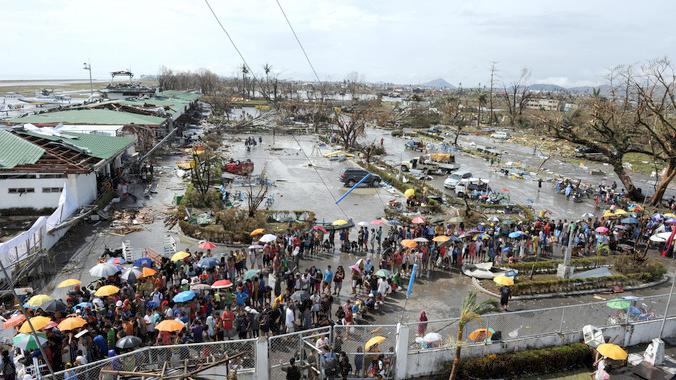 For those watching the news the past few days it should come as no surprise that Typhoon Haiyan (Yolanda locally) – one of the strongest ever to make landfall – has wreaked devastation across a central swath of the Philippines (and is headed in weakened state for Vietnam). The death toll could well top 10,000 and the naval forces of the Philippines, the U.S., and other nations are expected to help in the recovery efforts.
For those watching the news the past few days it should come as no surprise that Typhoon Haiyan (Yolanda locally) – one of the strongest ever to make landfall – has wreaked devastation across a central swath of the Philippines (and is headed in weakened state for Vietnam). The death toll could well top 10,000 and the naval forces of the Philippines, the U.S., and other nations are expected to help in the recovery efforts.
On Saturday Secretary Chuck Hagel announced that Pacific Command will initially provide “surface maritime SAR, medium-heavy helicopter lift support, airborne maritime SAR, fixed-wing lift support, and logistics enablers.” Marines from 3rd Marine Expeditionary Brigade (MEB) in Okinawa, along with KC-130J Hercules, MV-22 Ospreys, and P-3C Orions are in the Philippines or expected to arrive shortly.
Naval forces may have been told in the days prior to ‘lean forward’, which would complete the journey soon for sustained Humanitarian Assistance / Disaster Response (HA/DR) efforts. These are in addition to the U.S. forces and AID efforts already present, mostly in the south of the nation.
I’m hearing “US Navy assets are leaning forward towards Philippines” but no official statement yet.
— Raymond Pritchett (@Galrahn) November 9, 2013
Meanwhile analysts and foreign observers are watching to see China’s reaction – whether it comes in the form of aid or taking the opportunity to press its “changing the situation on the ground” approach to territorial claims.
Two ways to personally provide support to relief efforts are through the Red Cross and Team Rubicon. Please also remember the greatest need is often weeks after the initial disaster.

I feel so sorry for the folks who live in/around Tacloban who have just underwent horrific death and destruction because of Typhoon Haiyan. CNN reports that 10,000 are feared dead and “Worse than Hell” in the Phillipines. I was a member of the US Navy Amphibious Forces stationed there for a short time before moving on to Okinawa during WW II.
I recall the devastation caused by Typhoon Louise when it hit Okinawa on 9 Oct 1945.
Personnel of my unit were living in tents on that Island at the time – we were swept away by the storm. (A time in my life that I shall remember forever.)
The Website at http://www.history.navy.mil/faqs/faq102-6.htm summarizes the devastation caused by that storm. The story, in part, is quoted below:
“On 4 October 1945, a typhoon was spotted developing in the Caroline Islands and tracked as it moved on a predictable course to the northwest. Although expected to pass into the East China Sea north of Formosa on 8 October, the storm unexpectedly veered north toward Okinawa. That evening the storm slowed down and, just as it approached Okinawa, began to greatly increase in intensity. The sudden shift of the storm caught many ships and small craft in the constricted waters of Buckner Bay (Nakagusuku Wan) and they were unable to escape to sea. On 9 October, when the storm passed over the island, winds of 80 knots (92 miles per hour) and 30-35 foot waves battered the ships and craft in the bay and tore into the quonset huts and buildings ashore. A total of 12 ships and craft were sunk, 222 grounded, and 32 severely damaged. Personnel casualties were 36 killed, 47 missing, and 100 seriously injured. Almost all the food, medical supplies and other stores were destroyed, over 80% of all housing and buildings knocked down, and all the military installations on the island were temporarily out of action. Over 60 planes were damaged as well, though most were repairable. Although new supplies had been brought to the island by this time, and emergency mess halls and sleeping quarters built for all hands, the scale of the damage was still very large. If the war had not ended on 2 September, this damage, especially the grounding and damage to 107 amphibious craft (including the wrecking of four tank landing ships, two medium landing ships, a gunboat, and two infantry landing craft) would likely have seriously impacted the planned invasion of Japan (Operation Olympic).”
“Conditions on shore were no better. Twenty hours of torrential rain soaked everything, made quagmires of roads, and ruined virtually all stores. The hurricane winds destroyed from 50% to 95% of all tent camps, and flooded the remainder. Damage to Quonset huts ran from 40% to 99% total destruction. Some of these Quonsets were lifted bodily and moved hundreds of feet; others were torn apart, galvanized iron sheets ripped off, wallboarding shredded, and curved supports torn apart. Driven from their housing, officers and men alike were compelled to take shelter in caves, old tombs, trenches, and ditches in the open fields, and even behind heavy road-building machinery, as the wind swept tents, planks, and sections of galvanized iron through the air.”